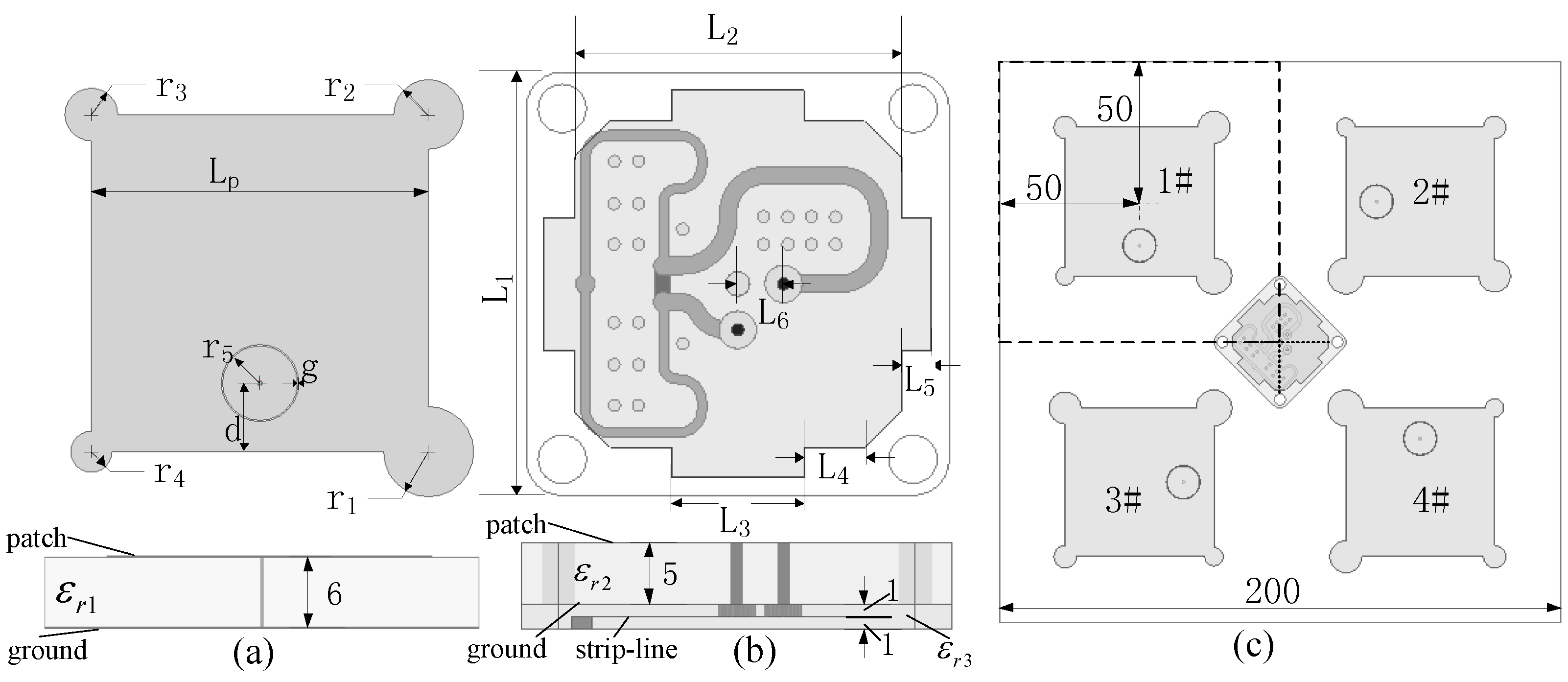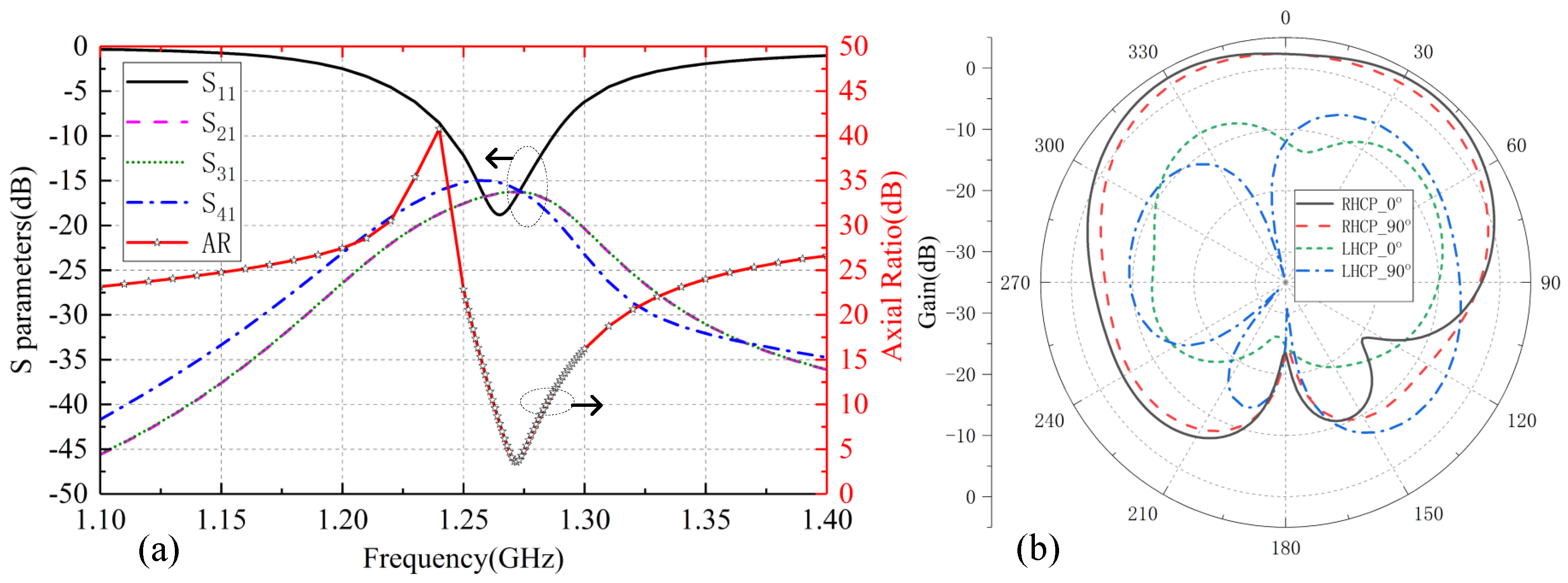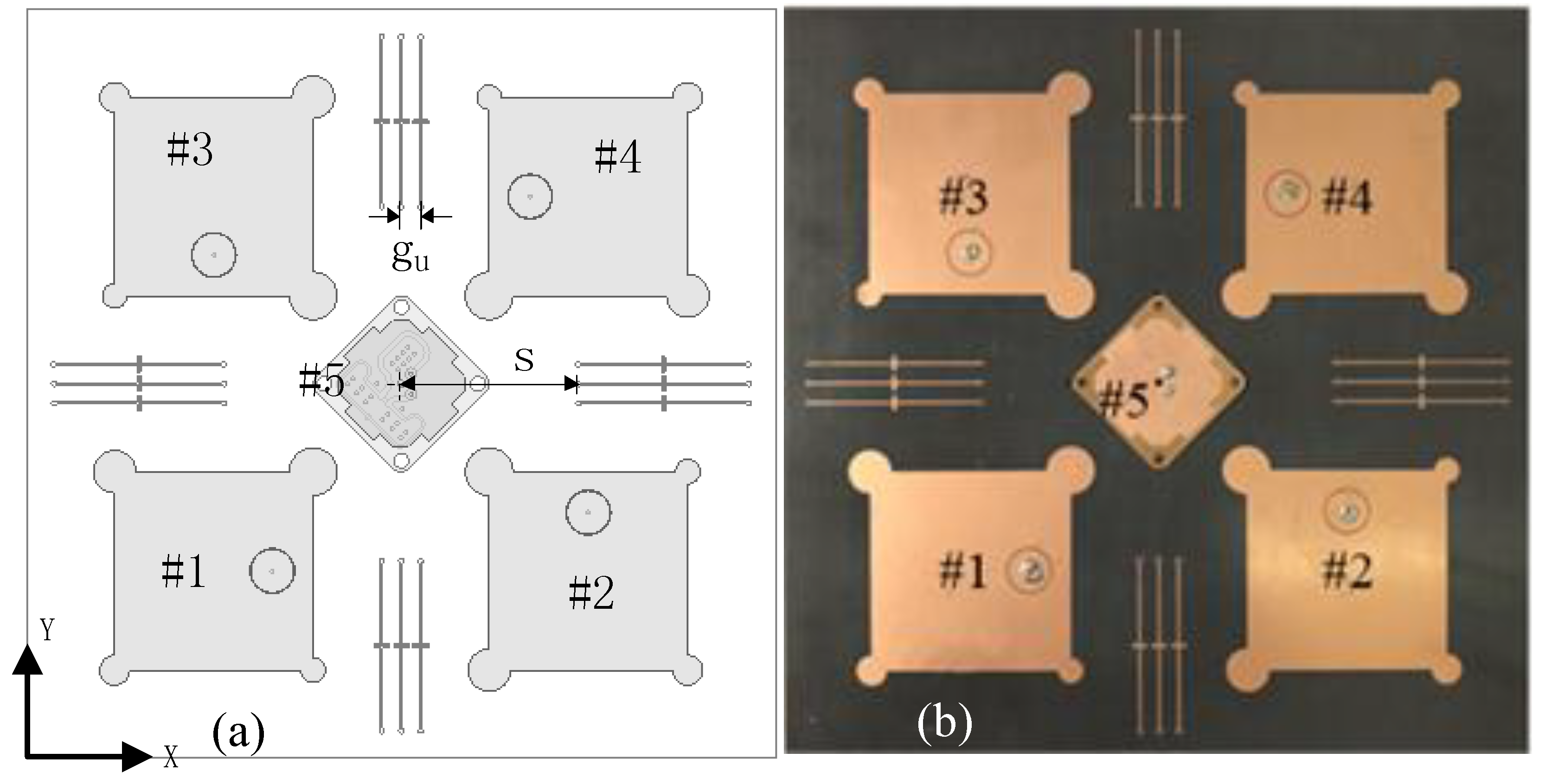Circularly Polarized Array with Enhanced Isolation Using Magnetic Metamaterials
Abstract
:1. Introduction
2. Antenna Design
2.1. BDS and GPS/GLONASS Antenna Element and Array
2.2. Unit Cell of the Magnetic Metamaterial
2.3. Array with Magnetic Metamaterials
3. Results and Discussion
4. Improvement of Anti-Jamming Ability
- The AARP decreases with the increase of SINR threshold.
- The AARP decreases with the increase of the number of jammers.
- The AARP is lower with the BWCW jammer than that with the STCW jammer.
- With the STCW jammer, where the ability margin of the system is quite sufficient, the AARPs for the system with and without the isolation structures have no big difference.
- With the WBCW jammer, where the ability margin of the system is not sufficient, the AARP for the system with isolation structures is obviously higher than that without isolation structures.
5. Conclusions
Author Contributions
Funding
Conflicts of Interest
Abbreviations
| BDS | (China) Beidou Navigation Satellite System |
| GPS | (America) Global Positioning System |
| GLONASS | (Russia) Global Navigation Satellite System |
| SI-SRR | Substrate Integrated Split Ring Resonator |
| MM | Magnetic Metamaterial |
| SINR | Signal to Interference plus Noise Ratio |
| AARP | Available Angle Region percentage |
| STCW | Single Tone Continuous Wave |
| BWCW | Wide Band Continuous Wave |
References
- Fante, R.L.; Blanchard, J.; Correia, J.; Nissen, T.C. Cancellation of jammers and jammer multipath in a GPS receiver. In Proceedings of the IEEE 1998 Position Location and Navigation Symposium, Palm Springs, CA, USA, 20–23 April 1998; pp. 622–625. [Google Scholar]
- Falcone, K.; Dimos, G.; Yang, C.; Nima, F.; Wolf, S.; Yam, D.; Weinfeldt, J.; Olson, P. Small Affordable Anti-Jam GPS Antenna (SAAGA) Development. In Proceedings of the International Technical Meeting of the Satellite Division of the Institute of Navigation, Nashville, TN, USA, 14–17 September 1999; pp. 1149–1156. [Google Scholar]
- Reynolds, D.; Brown, A.; Reynolds, A. Miniaturized GPS Antenna Array Technology and Predicted Anti-Jam Performance. In Proceedings of the 12th International Technical Meeting of the Satellite Division of the Institute of Navigation, ION GPS, Nashville, TN, USA, 14–17 September 1999; pp. 777–786. [Google Scholar]
- Ali, M.A.; Wahid, P. Effect of mutual coupling in adaptive arrays. Microw. Opt. Technol. Lett. 2002, 35, 270–274. [Google Scholar] [CrossRef]
- Iskander, M.A. Mitigation of mutual coupling effects in microstrip adaptive arrays for portable devices. In Proceedings of the 28th National Radio Science Conference (NRSC), Cairo, Egypt, 26–28 April 2011; pp. 1–10. [Google Scholar]
- Deger, S.; Saka, B. Effect of Mutual Coupling on the Performance of Adaptive Arrays. In Proceedings of the IEEE 14th Signal Processing and Communications Applications, Antalya, Turkey, 17–19 April 2006; pp. 1–4. [Google Scholar]
- OuYang, J.; Yang, F.; Wang, Z.M. Reducing Mutual Coupling of Closely Spaced Microstrip MIMO Antennas for WLAN Application. IEEE Antennas Wirel. Propag. Lett. 2011, 10, 310–313. [Google Scholar] [CrossRef]
- Luo, C.; Hong, J.; Zhong, L. Isolation Enhancement of a Very Compact UWB-MIMO Slot Antenna with Two Defected Ground Structures. IEEE Antennas Wirel. Propag. Lett. 2015, 14, 1766–1769. [Google Scholar] [CrossRef]
- Panda, P.K.; Ghosh, D. Isolation Enhancement of Patch Antennas using Metamaterial Superstrate. In Proceedings of the IEEE International Symposium on Antennas and Propagation & USNC/URSI National Radio Science Meeting, San Diego, CA, USA, 9–14 July 2017; pp. 1739–1740. [Google Scholar]
- Alsath, M.G.; Kanagasabai, M.; Balasubramanian, B. Implementation of Slotted Meander-Line Resonators for Isolation Enhancement in Microstrip Patch Antenna Arrays. IEEE Antennas Wirel. Propag. Lett. 2013, 12, 15–18. [Google Scholar] [CrossRef]
- Expósito-Domínguez, G.; Fernandez-Gonzalez, J.M.; Padilla, P.; Sierra-Castaner, M. Mutual Coupling Reduction Using EBG in Steering Antennas. IEEE Antennas Wirel. Propag. Lett. 2012, 11, 1265–1268. [Google Scholar] [CrossRef]
- Liu, Z.; Wang, J.; Qu, S.; Zhang, J.; Ma, H.; Xu, Z.; Zhang, A. Enhancing isolation of antenna arrays by simultaneously blocking and guiding magnetic field lines using magnetic metamaterials. Appl. Phys. Lett. 2016, 109, 153505. [Google Scholar] [CrossRef]
- Gheethan, A.; Herzig, P.A.; Mumcu, G. Compact 2 × 2 coupled double loop GPS antenna array loaded with broadside coupled split ring resonators. IEEE Trans. Antennas Propag. 2013, 61, 3000–3008. [Google Scholar] [CrossRef]
- Anjani, Y.S.; Alphones, A. A Wide-Beam Circularly Polarized Asymmetric-Microstrip Antenna. IEEE Trans. Antennas Propag. 2015, 63, 3764–3768. [Google Scholar]
- Pendry, J.B.; Holden, A.J.; Robbins, D.J.; Stewart, W.J. Magnetism from conductors and enhanced nonlinear phenomena. IEEE Trans. Microw. Theory Tech. 1999, 47, 2075–2084. [Google Scholar] [CrossRef]
- O’Brien, S.; Pendry, J.B. Photonic band-gap effects and magnetic activity in dielectric composites. J. Phys. Condens. Matter 2002, 14, 4035–4044. [Google Scholar] [CrossRef]
- Ishikawa, A.; Tanaka, T.; Kawata, S. Negative magnetic permeability in the visible light region. Phys. Rev. Lett. 2006, 95, 237401. [Google Scholar] [CrossRef] [PubMed]
- Ramakrishna, S.A. Physics of negative refractive index materials. Rep. Prog. Phys. 2005, 68, 449–521. [Google Scholar] [CrossRef]
- Smith, D.R.; Schultz, S.; Markoš, P.; Soukoulis, C.M. Determination of effective permittivity and permeability of metamaterials from reflection and transmission coefficients. Phys. Rev. B 2001, 65, 195104. [Google Scholar] [CrossRef]
- Smith, D.R.; Vier, D.C.; Koschny, T.; Soukoulis, C.M. Electromagnetic parameters retrieval from inhomogeneous metamaterials. Phys. Rev. E Stat. Nonlinear Soft Matter Phys. 2005, 71, 36617. [Google Scholar] [CrossRef] [PubMed] [Green Version]










| Paramenters | d | g | ||||||
| Value(mm) | 52.3 | 10.85 | 0.2 | 6.4 | 5.7 | 4 | 3.3 | 5.8 |
| Paramenters | ||||||
| Value(mm) | 35 | 27 | 11 | 5.04 | 2.5 | 3.8 |
| Substrate | Thickness (mm) | ||
|---|---|---|---|
| Layer1 | 3.4 | 0.0027 | 6 |
| Layer2 | 10 | 0.001 | 5 |
| Layer3 | 2.65 | 0.001 | 1 |
| Paramenters | |||||||
| Value(mm) | 0.5 | 0.4 | 4 | 42.5 | 1.4 | 0.8 | 0.2 |
© 2019 by the authors. Licensee MDPI, Basel, Switzerland. This article is an open access article distributed under the terms and conditions of the Creative Commons Attribution (CC BY) license (http://creativecommons.org/licenses/by/4.0/).
Share and Cite
Li, B.; Yang, C.; Yang, Z.; Shi, J.; Li, J.; Zhang, A. Circularly Polarized Array with Enhanced Isolation Using Magnetic Metamaterials. Electronics 2019, 8, 1356. https://doi.org/10.3390/electronics8111356
Li B, Yang C, Yang Z, Shi J, Li J, Zhang A. Circularly Polarized Array with Enhanced Isolation Using Magnetic Metamaterials. Electronics. 2019; 8(11):1356. https://doi.org/10.3390/electronics8111356
Chicago/Turabian StyleLi, Bo, Chun Yang, Zhanping Yang, Junwei Shi, Jianxing Li, and Anxue Zhang. 2019. "Circularly Polarized Array with Enhanced Isolation Using Magnetic Metamaterials" Electronics 8, no. 11: 1356. https://doi.org/10.3390/electronics8111356





